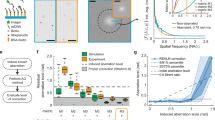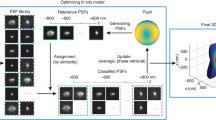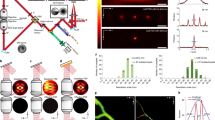Abstract
Application of single-molecule switching nanoscopy (SMSN) beyond the coverslip surface poses substantial challenges due to sample-induced aberrations that distort and blur single-molecule emission patterns. We combined active shaping of point spread functions and efficient adaptive optics to enable robust 3D-SMSN imaging within tissues. This development allowed us to image through 30-μm-thick brain sections to visualize and reconstruct the morphology and the nanoscale details of amyloid-β filaments in a mouse model of Alzheimer’s disease.
This is a preview of subscription content, access via your institution
Access options
Access Nature and 54 other Nature Portfolio journals
Get Nature+, our best-value online-access subscription
$29.99 / 30 days
cancel any time
Subscribe to this journal
Receive 12 print issues and online access
$259.00 per year
only $21.58 per issue
Buy this article
- Purchase on Springer Link
- Instant access to full article PDF
Prices may be subject to local taxes which are calculated during checkout


Similar content being viewed by others
References
von Diezmann, A., Shechtman, Y. & Moerner, W. E. Chem. Rev. 117, 7244–7275 (2017).
Burke, D., Patton, B., Huang, F., Bewersdorf, J. & Booth, M. J. Optica 2, 177 (2015).
Baddeley, D. & Bewersdorf, J. Annu. Rev. Biochem. 87, 1 (2018).
Legant, W. R. et al. Nat. Methods 13, 359–365 (2016).
Cella Zanacchi, F., Lavagnino, Z., Faretta, M., Furia, L. & Diaspro, A. PLoS One 8, e67667 (2013).
Ku, T. et al. Nat. Biotechnol. 34, 973–981 (2016).
Zhao, Y. et al. Nat. Biotechnol. 35, 757–764 (2017).
von Diezmann, A., Lee, M. Y., Lew, M. D. & Moerner, W. E. Optica 2, 985–993 (2015).
Liu, S., Kromann, E. B., Krueger, W. D., Bewersdorf, J. & Lidke, K. A. Opt. Express 21, 29462–29487 (2013).
Babcock, H. P. & Zhuang, X. Sci. Rep. 7, 552 (2017).
McGorty, R., Schnitzbauer, J., Zhang, W. & Huang, B. Opt. Lett. 39, 275–278 (2014).
Tehrani, K. F., Xu, J., Zhang, Y., Shen, P. & Kner, P. Opt. Express 23, 13677–13692 (2015).
Huang, F. et al. Cell 166, 1028–1040 (2016).
Ji, N. Nat. Methods 14, 374–380 (2017).
Dudok, B. et al. Nat. Neurosci. 18, 75–86 (2015).
Tang, A.-H. et al. Nature 536, 210–214 (2016).
Sigal, Y. M., Speer, C. M., Babcock, H. P. & Zhuang, X. Cell 163, 493–505 (2015).
Cameron, B. & Landreth, G. E. Neurobiol. Dis. 37, 503–509 (2010).
Jay, T. R. et al. J. Neurosci. 37, 637–647 (2017).
Yuan, P. et al. Neuron 90, 724–739 (2016).
Tokunaga, M., Imamoto, N. & Sakata-Sogawa, K. Nat. Methods 5, 159–161 (2008).
Huang, F. et al. Nat. Methods 10, 653–658 (2013).
Booth, M. Opt. Express 14, 1339–1352 (2006).
Wang, B. & Booth, M. J. Opt. Commun. 282, 4467–4474 (2009).
Hanser, B. M., Gustafsson, M. G. L., Agard, D. A. & Sedat, J. W. J. Microsc. 216, 32–48 (2004).
Gould, T. J., Burke, D., Bewersdorf, J. & Booth, M. J. Opt. Express 20, 20998–21009 (2012).
Nelder, J. A. & Mead, R. Comput. J. 7, 308–313 (1965).
Débarre, D. et al. Opt. Lett. 34, 2495–2497 (2009).
Cella Zanacchi, F. et al. Nat. Methods 8, 1047–1049 (2011).
Radde, R. et al. EMBO Rep. 7, 940–946 (2006).
Huang, F., Schwartz, S. L., Byars, J. M. & Lidke, K. A. Biomed. Opt. Express 2, 1377–1393 (2011).
Huang, B., Jones, S. A., Brandenburg, B. & Zhuang, X. Nat. Methods 5, 1047–1052 (2008).
Li, X. et al. Nat. Methods 10, 584–590 (2013).
Smith, C. S., Joseph, N., Rieger, B. & Lidke, K. A. Nat. Methods 7, 373–375 (2010).
Acknowledgements
We thank G. Sirinakis and E. Allgeyer for programming assistance with the deformable mirror. This work was supported by DARPA (grant D16AP00093 to F.H.), the NIH (grant R35 GM119785 to F.H.; grants R01 AG050597, R01 AG023012 and RF1 AG051495 to B.T.L. and G.E.L.), the Indiana Clinical and Translational Sciences Institute, funded in part by grant UL1TR001108 from the NIH (P.J.C., S.M.B., B.T.L., and G.E.L.), the National Center for Advancing Translational Sciences (P.J.C., S.M.B., B.T.L., and G.E.L.), the Alzheimer’s Association (P.J.C., S.M.B., B.T.L., and G.E.L.), the Jane & Lee Seidman Fund (P.J.C., S.M.B., B.T.L., and G.E.L.), generous donations from Chet & Jane Scholtz and Dave & Susan Roberts (P.J.C., S.M.B., B.T.L., and G.E.L.), the National Institute on Aging (grant NRSA F30 AG055261 to P.J.C.), and Case Western Reserve University (CWRU NDD T32 NS077888 and CWRU MSTP T32 GM725039 to P.J.C.).
Author information
Authors and Affiliations
Contributions
M.J.M. and F.H. conceived the project. M.J.M. developed the microscope setup and instrumentation control. M.J.M., S.L., and F.H. performed data analysis and simulation. M.J.M., B.T.L., G.E.L., and F.H. designed the experiments. M.J.M., P.J.C.-H., S.M.B., T.J.M., and D.A.M. carried out the biological experiments. All of the authors wrote the manuscript.
Corresponding author
Ethics declarations
Competing interests
The authors declare no competing interests.
Additional information
Publisher’s note: Springer Nature remains neutral with regard to jurisdictional claims in published maps and institutional affiliations.
Integrated supplementary information
Supplementary Figure 1 Lateral localization precision at different depths.
Average lateral localization precisions at the focal plane as a function of bead depth for nine different beads, quantified using Cramér–Rao lower bound (CRLB, Methods). The PSFs without AO correction suffer from increased blurring due to depth as well as reduced numbers of photons. AO correction improves the quality of the PSF and the number of photons collected. The inclusion of Adaptive Astigmatism (AA) spreads the PSF signal out compared to the AO only PSFs resulting in a slightly (~20%) worse lateral localization precision. However, this slight loss in lateral precision is acceptable compared to the significant gain in axial localization precision (Fig. 1L).
Supplementary Figure 2 Zernike mode corrections for the data in Figs. 1 and 2.
Corrected Zernike mode amplitudes (A.U.) for (A) PSFs in Fig. 1, (B) COS-7 cell labeled with TOM20-Alexa 647 in Fig. 1N and (C) beta-amyloid plaque image in Fig. 2. Zernike Mode numbers correspond to the Noll indices; Oblique Astigmatism (Z5), Vertical Astigmatism (Z6), Horizontal Coma (Z7), Vertical Coma (Z8), 1st order Spherical Aberration (Z11), and 2nd order Spherical Aberration (Z22). The data in A is representative of eight repeated experiments. The data in B is representative of three imaged cells and the data in C is representative of 37 imaged plaques.
Supplementary Figure 3 The axial localization precision determined from the Cramér–Rao lower bound.
The data from Fig. 1L is presented here containing a total of nine beads at different depths. A) The best axial localization precision is plotted for each PSF with the shaded regions representing the average localization precision calculated from CRLB at ±500 nm from the axial position of the optimal localization precision. The lines correspond to the axial localization precision for the imaged beads with no AO correction (short dashed line, cyan shade), AO correction (long dashed line, magenta shade), and AO with AA (solid line, yellow shade). Constant astigmatism was used for no AO and AO, while adaptive astigmatism was used to preserve the PSF modulation at each depth. B) Astigmatic PSF cutouts from depths of 14.4 µm (green outline), 120 µm (blue outline) and 170 µm (red outline) recorded at three different focal positions (top panel: +480 nm, middle: in focus and bottom: -480 nm) illustrate the difference in PSF quality. PSFs beyond the coverslip and not corrected with AO feature suppressed stretching when out of focus, limiting the precision of axial localization. Number of photons of bead and background used in simulation: 1000 photons and 10 background for AO and AO+AA. Photon numbers decrease without AO and were estimated as described in Methods.
Supplementary Figure 4 Lateral and axial views of different PSFs.
Additional examples of PSFs from Fig. 1 are shown with and without AO correction. A total of nine beads at different depths were recorded. Color scale and relative axial positions are preserved at each depth. Scale bar is 500 nm.
Supplementary Figure 5 Astigmatism calibration curves.
The astigmatism calibration curves for all nine beads at different depths (a subset was shown in Fig. 1). The widths of the PSFs are measured and combined into a single calibration curve using the metric, \(\omega _x^3/\omega _y - \omega _y^3/\omega _x\). Calibration curves without AO correction using the metric (A) or the measured widths (D). The slope of the calibration curves (A) decreases at greater depths reducing the range and sensitivity of the axial localizations. The insets with the green (orange) outline show the PSF 360 nm below (above) the focal plane of the 45.4 µm (92.0 µm) deep bead. Removing aberrations improves the calibration curves (B, E). Up to ~10 µm, the calibration curves nearly overlap. The magnitude of astigmatism can be increased based on the imaging depth to ensure that the calibration curves overlap (C, F). PSF modulation is enforced to match the calibration curve on the coverslip. Scale bar is 500 nm.
Supplementary Figure 6 Drift correction and section alignment.
This outlines the process for 3D drift correction and optical section alignment between different steps and different cycles. First, the optical sections across all cycles are aligned, followed by alignment of each optical section using the overlapping imaged features.
Supplementary Figure 7 Three-dimensional SMSN images of multiple amyloid-β plaques.
The plaques cover a range of sizes and were measured at various depths in 30 µm mouse frontal cortex tissue samples. These images are representative of the 37 total images recorded for this work. The scale bar is 5 µm and applies to all panels.
Supplementary Figure 8 Histograms of the localization precision.
(A-I) Histograms of the lateral localization precision along one lateral dimension from the images in Supplemental Figure 7. (J) Measured mean localization precision and uncertainty at different depths. Each data point represents the mean localization precision as a function of plaque depth. The error bars represent the standard deviations of the localization precisions. Beneath each data point is the corresponding panel letter from Supplementary Figure 7 or Figure 2. The sample size (number of localizations) for each data set, in order of depth are: I: 1,105,847, D: 858,665, B: 2,767,631, F: 763,919, G: 582,335, C: 515,184, E: 1,082,831, A: 489,089, Fig 2: 1,248,019, H: 511,664 and can also be found in Supplementary Table 2.
Supplementary Figure 9 Axial profiles of filaments in Fig. 2.
The axial line profiles of the amyloid-β filaments of various sizes from the images presented in Fig. 2. Line profiles from a total of 38 fibrils were measured.
Supplementary Figure 10 The axial profile of four randomly selected fibrils from four plaques in Supplementary Fig. 7.
Four fibrils from panels A, E, F and H were measured. The numerical values in each plot are the FWHM of each profile in nanometers. The diameters of the plaques were roughly measured to be 12, 17, 11 and 11 µm for panels A, E, F and H, respectively.
Supplementary Figure 11 Raw data and astigmatism widths.
Raw single molecule data from (A) a single frame without adaptive optics implementation and (B) with adaptive optics and adaptive astigmatism. The raw data in B is from Fig. 2. Both regions were recorded at similar depths in the tissue, ~22 µm. The expanded views show the presence of aberrations and inhibited astigmatism (i-iii) without the use of AO. The expanded views with AO and AA (iv-vi) reveal that aberrations were largely removed, and astigmatism restored. The contour plots show a comparison of the PSF widths, σy vs. σx for (C) no AO and (D) with AO and adaptive astigmatism. The use of both adaptive optics and adaptive astigmatism improves the modulation of the PSF such that 3D information can be gained (D) whereas that information is largely lost without AO (C). The raw data presented here is representative of the 3 regions recorded without AO correction (A) and the 37 regions imaged with AO correction (B). Scale bars are 5 µm in (A, B) and 500nm in (i-vi).
Supplementary Figure 12 Normalized reconstruction of 3D-SMSN images of multiple amyloid-β plaques.
During super-resolution reconstruction, voxels (voxel size 6 nm by 6 nm by 6 nm) which contains single molecule localizations will be assigned a constant value (instead of a value corresponding to the number of localizations as in Supplementary Figure 7) and subsequently blurred and colored according to their axial location for rendering. These images are representative of the 37 total images recorded for this work. Scale bar is 5 µm and applies to all panels.
Supplementary Figure 13 Diagram of the fluorescence emission path.
The lenses were carefully chosen to match the pupil diameter (3.8 mm) with the working diameter of the deformable mirror (4.4 mm) with slight under-filling to avoid vignetting. Focal lengths are, L1: 88.9 mm, L2: 250 mm, L3: 400 mm, L4: 150 mm, L5: 150 mm and L6: 75 mm.
Supplementary Figure 14 Characterized adaptive astigmatism amplitude and apparent focal shift.
(A) The magnitude of astigmatism as a function of depth to achieve the depth-independent calibration curve(s) in Fig. 1K and Supplementary Figure 5C is represented by the solid line, while the dashed black line shows the constant astigmatism used in Supplementary Figure 5A,B. (B) The apparent focal position of the beads with and without adaptive optics correction were carefully measured to determine the apparent focal shift due to the index mismatch.
Supplementary Figure 15 Histograms of localization precisions.
(A) Histogram of the averaged lateral localization precisions calculated from CRLB described in Methods based on background, axial position and photon emitted from single molecules assuming emitter locates at the center of the sub-region for Fig. 1N. (B) The axial localization precisions as calculated as described in Methods based on background, axial position and photon emitted from each localized single molecule for Fig. 1N. The calculations for (C) lateral and (D) axial localizations precisions for Fig. 2. Note that these axial precision measures correspond well (after converting into FWHM values) with FWHM of line profiles through thin filaments shown in Supplementary Figure 9.
Supplementary information
Supplementary Text and Figures
Supplementary Figures 1–15, Supplementary Tables 1 and 2 and Supplementary Notes 1–4
Supplementary Data 1
Raw single-molecule data with and without AO correction
Supplementary Software
Labview module used to implement the simplex algorithm
Rights and permissions
About this article
Cite this article
Mlodzianoski, M.J., Cheng-Hathaway, P.J., Bemiller, S.M. et al. Active PSF shaping and adaptive optics enable volumetric localization microscopy through brain sections. Nat Methods 15, 583–586 (2018). https://doi.org/10.1038/s41592-018-0053-8
Received:
Accepted:
Published:
Issue Date:
DOI: https://doi.org/10.1038/s41592-018-0053-8
This article is cited by
-
Six-dimensional single-molecule imaging with isotropic resolution using a multi-view reflector microscope
Nature Photonics (2023)
-
Label-free adaptive optics single-molecule localization microscopy for whole zebrafish
Nature Communications (2023)
-
Deep learning-driven adaptive optics for single-molecule localization microscopy
Nature Methods (2023)
-
Near-infrared-II deep tissue fluorescence microscopy and application
Nano Research (2023)
-
Targeted volumetric single-molecule localization microscopy of defined presynaptic structures in brain sections
Communications Biology (2021)



